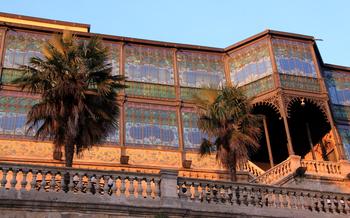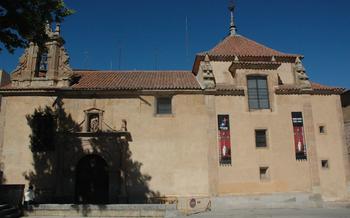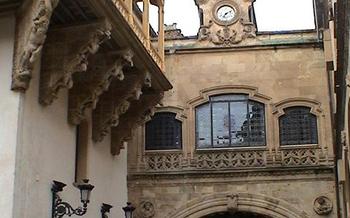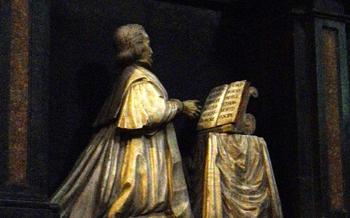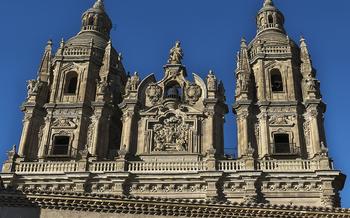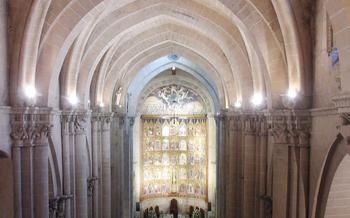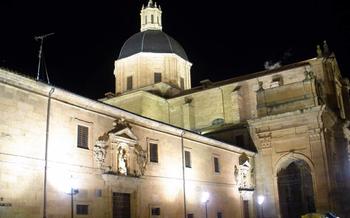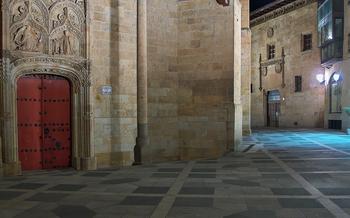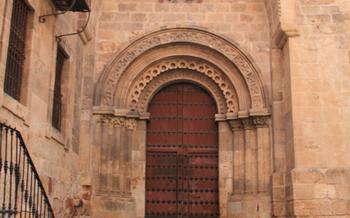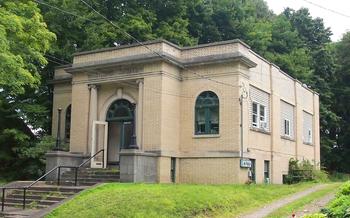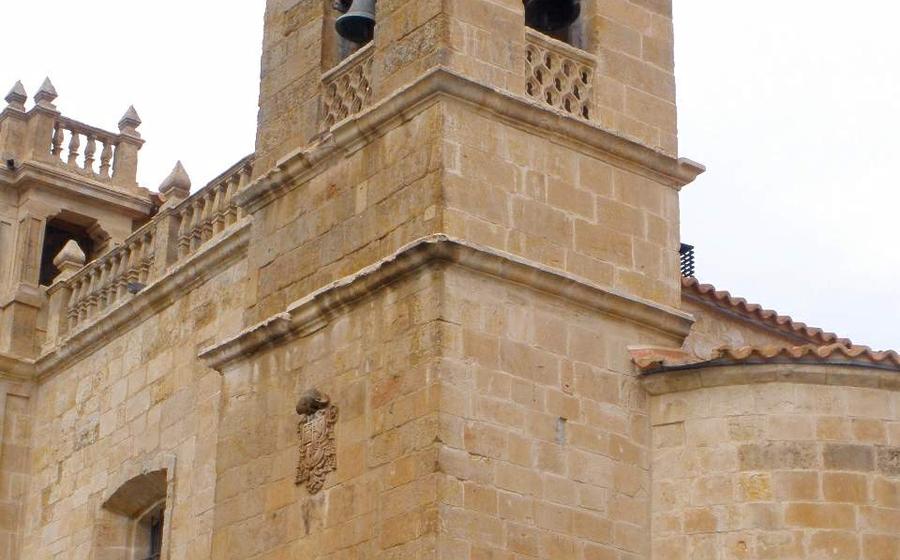
Church of San Millán
- Historical Significance
- Architectural Marvel
- Religious Significance
- Art and Murals
- Cultural Importance
- Location and Accessibility
- Visiting Hours and Admission:
- Dress Code and Etiquette
- Photography and Social Media
- Local Legends and Folklore
- Nearby Attractions
- Accessibility for Visitors with Disabilities
- Local Cuisine and Restaurants
- Accommodation Options
- Insider Tip:
Historical Significance
The Church of San Millán stands as a testament to Salamanca's rich cultural and religious heritage. Its roots trace back to the 12th century, emerging as a Romanesque structure before undergoing a transformation into the Gothic masterpiece it is today. The church's evolution mirrors the changing architectural styles of the era, showcasing the transition from Romanesque simplicity to the intricate ornamentation and soaring heights of Gothic architecture.
Over the centuries, the Church of San Millán has witnessed significant historical events and played a pivotal role in shaping Salamanca's identity. Its walls have sheltered renowned historical figures, each leaving their mark on the church's narrative. Among them is the esteemed Spanish theologian and philosopher, Francisco de Vitoria, who is laid to rest within the church's sacred grounds. The presence of his tomb adds a layer of historical significance, drawing scholars and history enthusiasts alike to pay their respects and delve deeper into the intellectual legacy he left behind.
Architectural Marvel
The Church of San Millán stands as a testament to the grandeur of Gothic architecture. Its façade captivates with an intricate rose window, a symbol of divine light and heavenly glory. The beauty of the church extends within, revealing ribbed vaults that soar towards the heavens, supported by elegant columns. Stained-glass windows, a symphony of colors, bathe the interior in a mystical light, creating an atmosphere of awe and reverence. Among its many unique features, the church boasts a magnificent collection of gargoyles that adorn the exterior, each one a grotesque masterpiece that adds to the church's enchanting aura.
Religious Significance
The Church of San Millán holds deep religious significance as a place of worship and pilgrimage for Catholics. It is dedicated to San Millán, a revered 6th-century Spanish saint known for his dedication to spreading Christianity. Pilgrims from across the region and beyond flock to the church to pay homage to the saint and seek his intercession. Within the church, visitors can find sacred relics associated with San Millán, including fragments of his clothing and personal belongings. These relics are believed to possess miraculous powers and are often displayed during special religious ceremonies or events. The presence of these sacred objects adds to the church's spiritual aura and reinforces its importance as a center of faith and devotion.
Art and Murals
The Church of San Millán boasts an impressive collection of art and murals that captivate visitors with their beauty and historical significance. The walls and ceilings are adorned with exquisite frescoes, paintings, and sculptures, each telling a unique story from the Bible or the life of San Millán.
One of the highlights is the 15th-century altarpiece, a masterpiece of Gothic art. Carved in intricate detail and painted with vibrant colors, it depicts scenes from the life of Christ, including his birth, crucifixion, and resurrection. The altarpiece is a testament to the skill and artistry of the craftsmen who created it, and it serves as a focal point for the church's interior.
Visitors can also admire the stunning stained-glass windows that bathe the interior in a soft, colorful light. These windows depict various saints and biblical figures, creating a sense of awe and reverence within the sacred space. The play of light through the stained glass adds to the church's overall beauty and atmosphere, making it a truly immersive experience for visitors.
The Church of San Millán is a treasure trove of religious art, showcasing the talents of renowned artists and the devotion of the Catholic faithful. Its murals and sculptures not only enhance the church's aesthetic appeal but also provide a deeper understanding of its religious significance and history.
Cultural Importance
The Church of San Millán holds a significant position in Salamanca's cultural landscape. It serves as a vibrant hub, hosting a variety of events that enrich the city's cultural fabric. Concerts, exhibitions, and other cultural programs find a home within the church's hallowed walls, attracting both locals and visitors alike. These events not only showcase the church's versatility but also contribute to the city's vibrant cultural scene.
The church's inclusion as a UNESCO World Heritage Site further underscores its cultural significance. This prestigious recognition acknowledges the church's outstanding universal value and its contribution to the world's cultural heritage. It serves as a testament to the architectural, historical, and religious importance of the Church of San Millán, ensuring its preservation for future generations.
Moreover, the church is deeply intertwined with local traditions and customs. Throughout the year, it hosts special celebrations and events that reflect the city's rich cultural heritage. These occasions provide a glimpse into the vibrant religious and cultural traditions that have shaped Salamanca's identity.
Location and Accessibility
The Church of San Millán enjoys a strategic position in the heart of Salamanca's historic center, in close proximity to other notable landmarks. It is nestled amidst charming cobblestone streets, inviting visitors to embark on a journey through the city's rich past. Reaching the church is a breeze, with multiple public transportation options available. Several bus lines stop nearby, making it easily accessible from different parts of the city. For those arriving by car, there are designated parking areas within walking distance, ensuring a convenient visit. The church's central location allows visitors to seamlessly combine their visit with exploring other attractions, such as the Plaza Mayor, the University of Salamanca, or the Catedral Vieja, all within a leisurely stroll. Visitors with disabilities will find the church easily accessible, with ramps and elevators providing seamless entry and navigation throughout the building.
Visiting Hours and Admission:
The Church of San Millán welcomes visitors with open arms, inviting them to immerse themselves in its sacred atmosphere. The church's doors are typically open from 9 am to 7 pm, allowing ample time for exploration and contemplation. However, it's always advisable to check for any variations in visiting hours during special events or holidays, as the church may adjust its schedule accordingly.
Admission to the Church of San Millán is generally free of charge, allowing all visitors to experience its splendor without financial barriers. However, donations are gratefully accepted, as they contribute to the preservation and upkeep of this architectural marvel. For those seeking a deeper understanding of the church's history and significance, guided tours are available at an additional cost. These tours are offered in various languages, ensuring that visitors from around the world can delve into the church's rich tapestry of stories.
To fully appreciate the church's intricate details and serene ambiance, it's recommended to visit during quieter hours, such as early in the morning or late in the afternoon. This allows for a more intimate and contemplative experience, free from the hustle and bustle of crowds.
Dress Code and Etiquette
When visiting the Church of San Millán, it is important to dress respectfully, as it is a sacred place of worship. Visitors should avoid wearing shorts, tank tops, or revealing clothing. Shoulders and knees should be covered. It is also essential to maintain silence and show reverence while inside the church. Photography and videography are permitted, but using flash or tripods is not allowed. Visitors should refrain from talking loudly or engaging in disruptive behavior that may disturb other visitors or worshippers. Respecting the sanctity of the church and its significance to the local community is paramount, ensuring a peaceful and meaningful experience for all.
Photography and Social Media
When visiting the Church of San Millán, it is essential to be respectful of its sacred nature and the privacy of those who may be worshipping or praying. Photography is generally allowed inside the church, but visitors should be mindful of their surroundings and avoid using flash or tripods that may disturb others.
When sharing your photos on social media, consider using relevant hashtags such as #ChurchofSanMillan, #Salamanca, or #SpanishArchitecture to connect with others who share your interest in this beautiful church. Tagging the church's official social media accounts, if available, can help promote the church and spread awareness of its cultural significance.
Remember to caption your photos thoughtfully, providing insights into the history, architecture, or religious significance of the church. By sharing your experiences and stunning images, you can help inspire others to visit and appreciate this magnificent monument of faith and artistry.
Local Legends and Folklore
The Church of San Millán is steeped in local legends and folklore that add a touch of mystery and intrigue to its history. One popular tale tells of a hidden treasure buried beneath the church, said to have been left behind by a wealthy nobleman who sought refuge within its walls during a time of great turmoil. Locals believe that the treasure remains undiscovered, waiting for a worthy soul to find it.
Another legend speaks of a ghostly monk who roams the church at night, said to be the spirit of a former abbot who was unjustly accused of a crime. Visitors have reported seeing the monk's apparition, clad in a flowing white robe, gliding through the shadows of the church's interior.
These legends and stories are deeply embedded in the local culture and add to the church's mystique. They remind visitors of the rich heritage and traditions that surround this sacred site, encouraging them to explore the hidden depths of Salamanca's history and folklore.
Nearby Attractions
A visit to the Church of San Millán can be easily combined with other attractions in Salamanca's historic center. Just a short walk away, visitors can explore the Plaza Mayor, the main square of the city, with its stunning Baroque architecture and lively atmosphere. The University of Salamanca, one of the oldest and most prestigious in Europe, is also nearby, with its iconic Plateresque façade and ornate courtyards.
For those interested in art and culture, the Salamanca Museum, located in a former palace, houses a diverse collection of paintings, sculptures, and archaeological artifacts from different periods. The Casa Lis Art Nouveau and Art Deco Museum offers a glimpse into the artistic movements of the late 19th and early 20th centuries, showcasing beautiful stained-glass windows, furniture, and decorative arts.
To experience the vibrant local culture, visitors can stroll along the lively Calle Toro, lined with shops, bars, and restaurants, offering a taste of Salamanca's gastronomy and nightlife. The city also hosts various festivals and events throughout the year, including the Salamanca Festival, a renowned performing arts festival held in June, and the Salamanca New Year's Eve Celebration, known for its spectacular fireworks display.
Accessibility for Visitors with Disabilities
The Church of San Millán is committed to providing an inclusive and accessible experience for visitors of all abilities. The church features ramps and elevators to ensure that visitors with mobility challenges can easily access all areas of the building. Accessible seating is also available to ensure that everyone can participate in religious services and events comfortably. Additionally, the church offers special assistance and services to visitors with specific needs. Visitors are encouraged to inquire about accessibility options in advance to ensure a smooth and enjoyable visit. The church's staff is dedicated to assisting all visitors in making the most of their experience at the Church of San Millán.
Local Cuisine and Restaurants
After exploring the grandeur of the Church of San Millán, indulge in the culinary delights of Salamanca's vibrant food scene. Just a stone's throw from the church, you'll find an array of restaurants and cafes, each offering a unique taste of traditional Spanish cuisine.
For an authentic experience, try the nearby Taberna San Juan, where you can savor mouthwatering tapas and local specialties in a cozy atmosphere. Don't miss their signature dish, the "patatas bravas," crispy potatoes topped with a spicy sauce that will tantalize your taste buds.
If you're craving a hearty meal, head to Casa Paca, renowned for its traditional Spanish paella. This saffron-infused rice dish, brimming with seafood and succulent meats, is a must-try for any visitor to Salamanca.
For a lighter option, indulge in the local delicacy of "hornazo," a savory pastry filled with pork loin, chorizo, and hard-boiled eggs. You can find this regional specialty at many bakeries and cafes around the city.
And for those with dietary restrictions or preferences, Salamanca has plenty of options to cater to your needs. Vegetarian and vegan restaurants, as well as gluten-free and halal options, are readily available, ensuring that everyone can enjoy the culinary delights of this vibrant city.
Accommodation Options
When planning your visit to Salamanca, a wide range of accommodation options await you. From budget-friendly hostels to luxurious hotels, there's something to suit every traveler's needs and preferences. For a truly immersive experience, consider staying in a traditional Spanish guesthouse, known as a "hostal." These charming establishments often offer affordable rates and a warm, home-like atmosphere. If you prefer the comforts of a modern hotel, numerous options are available within walking distance of the Church of San Millán. For those seeking a unique and memorable stay, consider booking a room in a historic palace or converted convent, offering a glimpse into Salamanca's rich past. Remember to book your accommodation in advance, especially during peak tourist season (June-August), to secure the best rates and availability.
Insider Tip:
Venture into the church's hidden crypt to discover a secret chamber that holds the mummified remains of San Millán himself. This eerie and fascinating sight offers a glimpse into the church's ancient history and the enduring legacy of this revered saint. Be sure to visit during the annual feast day of San Millán on November 12th, when the church comes alive with processions, music, and a festive atmosphere. Remember to dress respectfully and maintain a solemn demeanor when exploring this sacred space.
